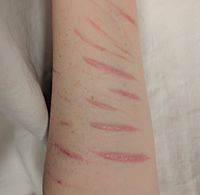
Photo from wikipedia
Background There have been numerous studies investigating the relationship between nonsuicidal self-injury (NSSI) and suicidality. On the one side, NSSI is an important risk factor for suicidality, including suicidal thoughts… Click to show full abstract
Background There have been numerous studies investigating the relationship between nonsuicidal self-injury (NSSI) and suicidality. On the one side, NSSI is an important risk factor for suicidality, including suicidal thoughts and behaviors. On the other side, it has been suggested that one function of NSSI might be as a coping mechanism that can help individuals in the short term avoid suicide. The present study investigated the relationship between suicidality and NSSI in female inpatient adolescents, focusing on NSSI as an anti-suicide strategy. Methods Subjects were 56 female adolescents, aged 12–18 years (M = 15.95 years, SD = 1.27), recruited from different inpatient child and adolescent psychiatric units. All participants fulfilled the DSM-5 research criteria for nonsuicidal self-injury disorder (NSSI-D). To assess suicidality, NSSI-D, and current and past diagnoses, a structured clinical interview was conducted. Results NSSI as a short-term coping strategy for avoiding suicide was indicated by one third (32.1%) of the participants. Before participants engaged in NSSI, the anti-suicide function was reported more frequently than reducing interpersonal problems (d = -.59). Getting relief from negative emotions and inducing positive feelings were reported at the same frequency as avoiding suicide before NSSI. Participants engaging in NSSI to avoid suicide and those reporting other functions did not significantly differ regarding other NSSI characteristics, suicidality, or psychopathology. Results indicate that the anti-suicide function significantly predicts the duration of current suicidal ideation (β = .557). Conclusion This study provides preliminary support for the idea that NSSI is frequently used by female adolescents with NSSI-D to avoid suicide. Given the high co-occurrence of NSSI and suicidality, our results underline the importance of clinical assessment of suicidality and several NSSI functions, including the anti-suicide function, in adolescents with NSSI.
Journal Title: Frontiers in Psychiatry
Year Published: 2020
Link to full text (if available)
Share on Social Media: Sign Up to like & get
recommendations!